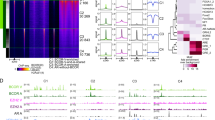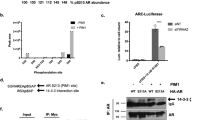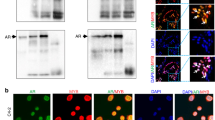Abstract
β-Catenin, a component of the Wnt signaling pathway, is a coactivator of human androgen receptor (hAR) transcriptional activity. Here, we show that Wnt signaling also influences androgen-mediated signaling through its ability to regulate hAR mRNA and protein in prostate cancer (PCa) cells. Three functional LEF-1/TCF binding sites lie within the promoter of the hAR gene as shown by CHIP assays that captured β-catenin-bound chromatin from Wnt-activated LNCaP cells. Chimeric reporter vectors that use the hAR gene promoter to drive luciferase expression confirmed that these LEF-1/TCF binding elements are able to confer robust upregulation of luciferase expression when stimulated by Wnt-1 or by transfection with β-catenin and that dominant-negative TCF or mutations within the dominant TCF-binding element abrogated the response. Semi-quantitative and real time RT-PCR assays confirmed that Wnt activation upregulates hAR mRNA in PCa cells. In contrast, hAR protein expression was strongly suppressed by Wnt activation. The reduction of hAR protein is consistent with evidence that Wnt signaling increased phosphorylation of Akt and its downstream target, MDM2 that promotes degradation of hAR protein through a proteasomal pathway. These data indicate that the hAR gene is a direct target of LEF-1/TCF transcriptional regulation in PCa cells but also show that the expression of the hAR protein is suppressed by a degradation pathway regulated by cross-talk of Wnt to Akt that is likely mediated by Wnt-directed degradation of the B regulatory subunit of protein phosphatase, PP2A.
This is a preview of subscription content, access via your institution
Access options
Subscribe to this journal
Receive 50 print issues and online access
$259.00 per year
only $5.18 per issue
Buy this article
- Purchase on Springer Link
- Instant access to full article PDF
Prices may be subject to local taxes which are calculated during checkout






Similar content being viewed by others
Accession codes
References
Ashcroft M, Ludwig RL, Woods DB, Copeland TD, Weber HO, MacRae EJ et al. (2002). Oncogene 21: 1955–1962.
Barker N, Clevers H . (2000). Bioessays 22: 961–965.
Chang C, Saltzman A, Yeh S, Young W, Keller E, Lee H-J et al. (1995). Crit Rev Eukaryot Gene Exp 5: 97–125.
Chen CD, Welsbie DS, Tran C, Baek SH, Chen R, Vessella R et al. (2004a). Nature Med 10: 33–39.
Chen G, Shukeir N, Potti A, Sircare K, Aprikian A, Goltzman D et al. (2004b). Cancer 10: 1345–1356.
Chen S, Guttridge DC, You Z, Zhang Z, Fribley A, Mayo MW et al. (2001). J Cell Biol 152: 87–96.
Chesire DR, Ewing CM, Sauvageot J, Bova GS, Isaacs WB . (2000). Prostate 45: 323–334.
Craft N, Chhor C, Tran C, Belldegrun A, DeKernion J, Witte ON et al. (1999). Cancer Res 59: 5030–5036.
de la Taille A, Rubin MA, Chen M-W, Vacherot F, Gil-Diez de Medina S, Burchardt M et al. (2003). Clin Cancer Res 9: 1804–1807.
Ford OH, Gregory CW, Kim D, Smitherman AB, Mohler JL . (2003). J Urol 170: 1817–1821.
Ghosh PM, Malik S, Bedolla R, Kreisberg JI . (2003). Curr Drug Metabol 4: 487–496.
Gil-Diez de Medina S, Salomon L, Colombel M, Abbou CC, Bellot J, Thiery JP et al. (1998). Hum Pathol 29: 1005–1012.
Grossmann ME, Huang H, Tindall DJ . (2001). J Natl Cancer Inst 93: 1687–1697.
He TC, Sparks AB, Rago C, Hermeking H, Zawel L, da Costa LT et al. (1998). Science 281: 1509–1512.
Kau TR, Schroeder F, Ramaswamy S, Wojciechowski CL, Zhao JJ, Roberts TM et al. (2003). Cancer Cell 4: 463–476.
Koh SS, Li H, Lee YH, Widelitz RB, Chuong CM, Stallcup MR . (2002). J Biol Chem 277: 26031–26035.
Latil A, Bieche I, Vadaud D, Lidereau R, Berthon P, Cussonet O et al. (2001). Cancer Res 61: 1919–1926.
Li H, Kim JH, Koh SS, Stallcup MR . (2004). J Biol Chem 279: 4212–4220.
Lin H-K, Wang L, Hu Y-C, Altuwaijri S, Chang C . (2002). EMBO J 21: 4037–4048.
Lustig B, Behrens J . (2003). J Cancer Res Clin Oncol 129: 199–221.
Miyamoto H, Messing EM, Chang C . (2005). Prostate 61: 332–353.
Ohigashi T, Mizuno R, Nakashima J, Marumo K, Murai M . (2005). Prostate 62: 61–68.
Rahman M, Miyamoto H, Chang C . (2004). Clin Cancer Res 10: 2208–2219.
Ratcliffe MJ, Itoh K, Sokol SY . (2000). J Biol Chem 275: 35680–35683.
Sancho E, Batlle E, Clevers H . (2004). Ann Rev Cell Develop Biol 20: 695–723.
Shi XB, Ma AH, Tepper CG, Xia L, Gregg JP, Gandour-Edwards R et al. (2004). Prostate 60: 257–271.
Song LN, Herrell R, Byers S, Shah S, Wilson EM, Gelmann EP . (2003). Mol Cell Biol 23: 1674–1687.
Stack S, Cribbs JT, Gomez L . (2004). J Biol Chem 279: 47732–47739.
Tetsu O, McCormick F . (1999). Nature 398: 422–426.
Tilley WD, Buchanan G, Hickey TE, Bentel JM . (1996). Clin Cancer Res 2: 277–285.
Truica CI, Byers S, Gelmann EP . (2000). Cancer Res 60: 4709–4713.
Verras M, Brown J, Li X, Nusse R, Sun Z . (2004). Cancer Res 64: 8860–8866.
Voeller HJ, Truica CI, Gelmann EP . (1998). Cancer Res 58: 2520–2523.
Watanabe M, Kakiuchi H, Kato H, Shraishi T, Yatani R, Sugimura T et al. (1996). Jap J Clin Oncol 26: 77–81.
Yang F, Li X, Sharma M, Sasaki CY, Longo DL, Lim B et al. (2002). J Biol Chem 277: 11336–11344.
Yang X, Chen M-W, Terry S, Vacherot F, Chopin DK, Bemis DL et al. (2005). Cancer Res 65: 5263–5271.
Young CS, Kitamura M, Hardy S, Kitajewski J . (1998). Mol Cell Biol 18: 2474–2485.
Acknowledgements
This work was supported by funding from the TJ Martell Foundation, New York, NCI (RO1 CA111618), Department of Defense (PC050402) and from l'Association pour la Recherche sur les Tumeurs de la Prostate, France. Xuezhen Yang is the White Fellow for Prostate Cancer Research. Debra L Bemis is the Charles Royce Fellow.
Author information
Authors and Affiliations
Corresponding author
Rights and permissions
About this article
Cite this article
Yang, X., Chen, MW., Terry, S. et al. Complex regulation of human androgen receptor expression by Wnt signaling in prostate cancer cells. Oncogene 25, 3436–3444 (2006). https://doi.org/10.1038/sj.onc.1209366
Received:
Revised:
Accepted:
Published:
Issue Date:
DOI: https://doi.org/10.1038/sj.onc.1209366
Keywords
This article is cited by
-
Nuclear receptor NURR1 functions to promote stemness and epithelial-mesenchymal transition in prostate cancer via its targeting of Wnt/β-catenin signaling pathway
Cell Death & Disease (2024)
-
Proteomic analysis of the developing mammalian brain links PCDH19 to the Wnt/β-catenin signalling pathway
Molecular Psychiatry (2024)
-
Opposite changes in the expression of clathrin and caveolin-1 in normal and cancerous human prostate tissue: putative clathrin-mediated recycling of EGFR
Histochemistry and Cell Biology (2023)
-
Design of Peptoid-peptide Macrocycles to Inhibit the β-catenin TCF Interaction in Prostate Cancer
Nature Communications (2018)
-
A novel statistical approach for identification of the master regulator transcription factor
BMC Bioinformatics (2017)



